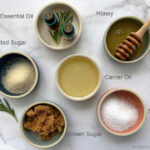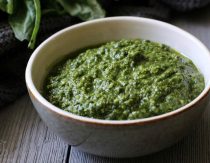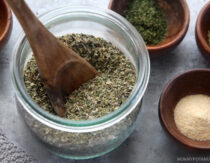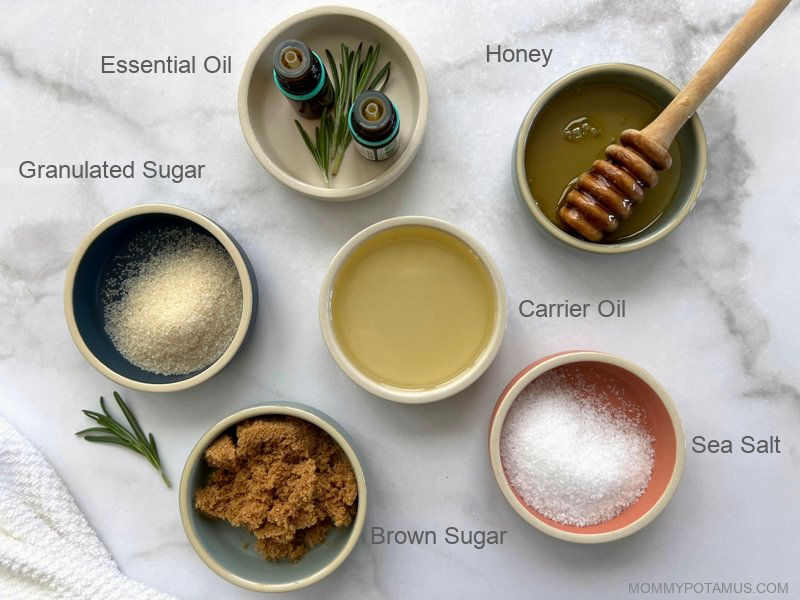
Are your nerves feeling a little frayed lately? Chances are it’s a good time to soothe the 14,000+ nerve endings you walk on every day . . . while also exfoliating and softening the soles of your feet, of course.
This DIY foot scrub uses gentle pressure to relax the 7,200 nerves contained in each of your feet, which in turn sends a message to your entire nervous system to release tension. Like all skin scrubs, its main purpose is to exfoliate away dry skin, and it does a great job of that, too.
That’s a good thing, because although our bodies are constantly sloughing off old skin cells and generating new cells, the process tends to slow down as we get older. The reduced turnover rate can create a buildup of old, dead skin cells, leading to dry, patchy, flaky or cracked skin.
Regular exfoliation helps optimize the shedding of dead skin cells, which stimulates the stratum corneum (outermost layer of our skin) to regenerate with more young, healthy cells. It also helps with the absorption of nourishing oils, body butters and lotions.
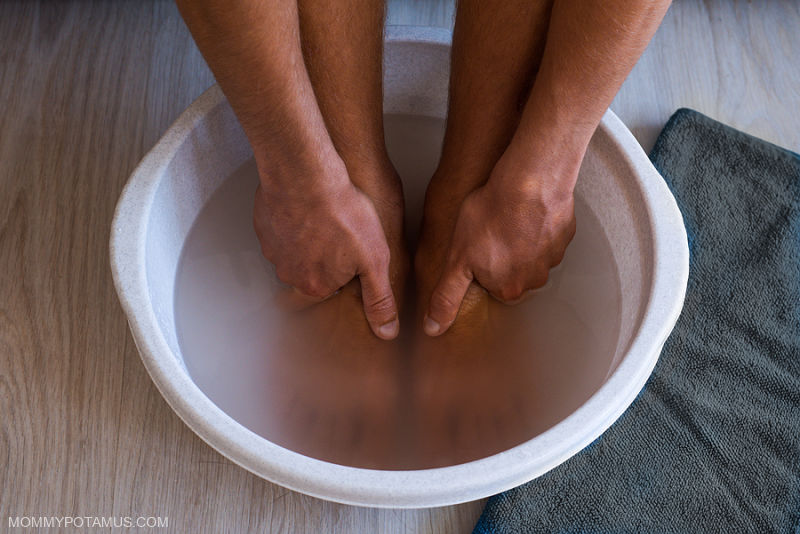
How To Use This Foot Scrub
Because the skin on the soles of our feet is tougher than, say, our elbows, there’s a little more involved in the exfoliation process. Here’s what I recommend:
1. Start With A Foot Soak
Warm water is excellent for softening up thick calluses so they can be sloughed off, and it’s also deeply therapeutic for tired feet.
To create a relaxing foot soak, fill your tub, sink or foot spa with warm/hot water and add 1/2-1 cup of epsom salt or 3-4 tablespoons baking soda to the water. Although baking soda will help soften skin, I prefer magnesium sulfate (epsom salt) because:
Magnesium is an electrolyte that supports skin hydration. In one study, researchers found that another magnesium-rich salt (Dead Sea salt) improved skin barrier function and enhanced skin hydration in participants with dry skin. They concluded that its beneficial properties “are most likely related to the high magnesium content” and that magnesium is known to support cell renewal and barrier repair. (1)
Although Dead Sea salt will work in this recipe, epsom salt is more affordable. I typically reach for it first and save the Dead Sea salt for special occasions.
Magnesium is well-absorbed through the skin and has lots of benefits beyond skin hydration. (2) It supports deep sleep, muscle relaxation, the production of a calming neurotransmitter called gamma-aminobutyric acid (GABA), detoxification, and healthy energy levels due to its role in the production of ATP (adenosine triphosphate), which are the energy packets made in our cells. Click here to read more about its many benefits here.
If you have very dry, thick skin, you may want to consider using a pumice stone before moving on to the scrub for a polished finish.
2. Apply The Scrub
Use a spoon to scoop a tablespoon or so out of your jar. The scrub, when stored properly, will last many months or longer, which is why you don’t want to introduce water or microbes into the jar.
Place the scrub in your palms. Apply in a circular motions over your feet, focusing on rough areas like the heels as needed. This scrub can make the shower slippery, so I prefer to apply in a bath or while using a footbath. If you do apply in the shower, I recommend using a stool and/or bath mat to avoid slipping.
Continue to massage until your skin feels soft, but make sure not to overdo things and cause irritation. Only use the foot scrub on intact skin – avoid any areas that are cut or inflamed. Rinse with warm water and pat skin dry.
3. Follow With A Moisturizer
Now that you’ve exfoliated away the dry skin, it’s time to seal in the mineral-rich water and lipids your skin has absorbed. A good moisturizer supports the barrier-protecting function of your stratum corneum, which is the lipid layer that keeps water from escaping through our skin into the environment (transepidermal water loss).
Some of my favorite moisturizers are:
Tallow balm – Tallow balm is uniquely compatible with our skin’s biology, leaving it supple and nourished after use. It’s perfect as a post-pedicure balm, daily face and body moisturizer, or as a soothing balm for sunburn or eczema. Here’s how to make it, and what to buy if you don’t want to DIY. Use MOMMYPOTAMUS at checkout for 10% off your first order.
Whipped body butter – This is my absolute favorite whipped body butter recipe. It’s not greasy, leaves skin feeling SO SOFT, and is super simple to make.
Lotion Bars – Luxurious and silky smooth, this blend of cocoa butter, coconut oil and beeswax is super easy to make. You’ll love the way it feels, and you’ll feel good about knowing what you’re putting on your skin.
Intensive Moisturizing Lotion – This DIY lotion recipe is nothing short of magical. All you need is a quick whir of the immersion blender to make a batch.
4. Repeat As Needed
The optimal time to reapply your foot scrub will vary based on a few factors including your overall skin type, the climate you live in, and what’s most convenient for you.
More is not necessarily better, because exfoliating too often can irritate your skin. Start with once per week and increase or decrease based on how your skin responds. Some people prefer 2-3 times per week, while others prefer every 2 weeks.
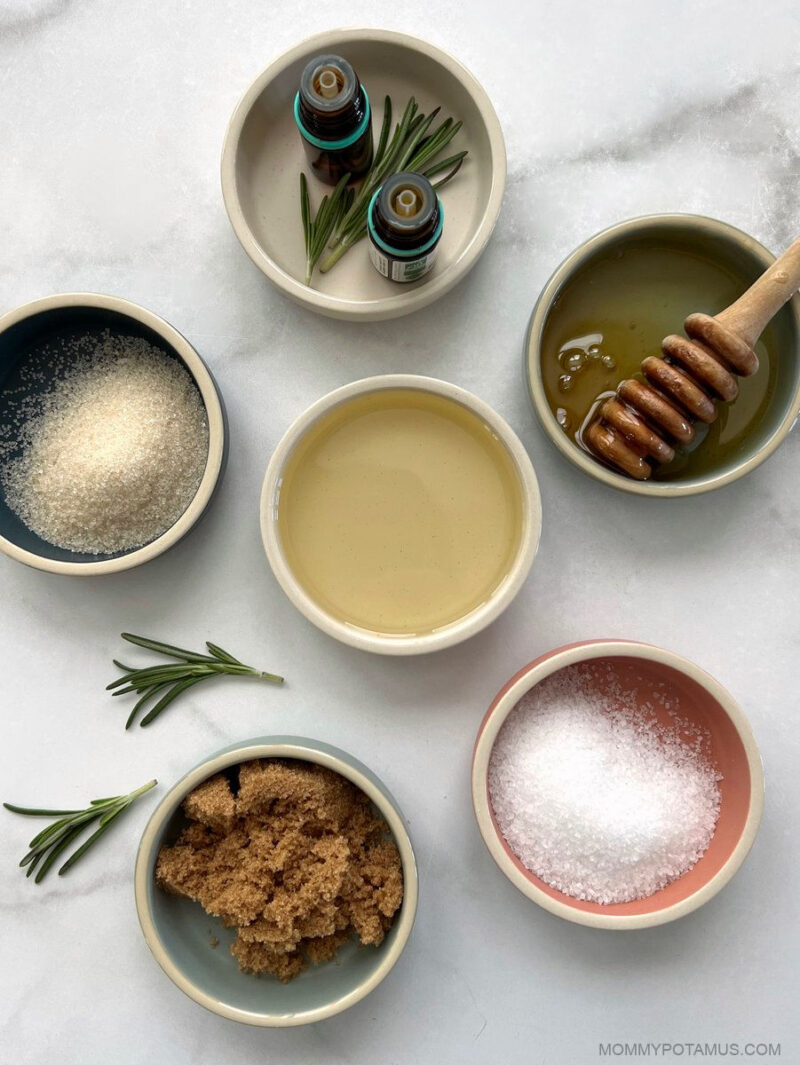
About The Ingredients
Sugar or Salt – Sugar contains naturally occurring glycolic acid, which helps to dissolve dead skin cells as it’s massaged into skin. It’s also a humectant, which means that it draws moisture to skin. Granulated white sugar is a little more coarsely ground than brown sugar, making it ideal for sloughing away skin. With that said, brown sugar makes an excellent polishing scrub when just a little roughness is present. Unrefined sugars like sucanat typically don’t work well as exfoliators.
Though salt doesn’t contain glycolic acid, certain unrefined salts are rich in minerals that nourish skin. It also has some antimicrobial properties, making it a good choice for a foot scrub. Whether you choose sugar or salt, something to keep in mind is that the size of the granules affects the exfoliating properties of your chosen ingredient. Small granules have a lighter, polishing effect while medium-size granules exfoliate more thoroughly. Very large granules tend to be ineffective.
Carrier Oil – Nourishing oils derived from olives, coconuts, olives or avocadoes infuse the skin with hydrating lipids.
Essential Oils – Although totally optional, essential oils like peppermint can deepen the refreshing/revitalizing experience of a good foot scrub. On the flipside, calming oils like lavender can enhance feelings of relaxation.
Honey – As I wrote about in this guide to washing your face with honey, it’s both a humectant (moisture gatherer) and cleanser that rinses away clean.
3 DIY Foot Scrub Recipes To Soothe Your Soles
Ingredients
Lavender + Honey Sugar Scrub
- 1 cup granulated sugar (can substitute salt if desired)
- ⅓-½ cup fractionated coconut oil, olive oil, sweet almond oil, or avocado oil
- 2 tbsp honey
- 30 drops lavender essential oil
Refreshing Peppermint Salt Scrub
- 1 cup fine to medium grind sea salt (can substitute sugar if desired)
- ⅓-½ cup fractionated coconut oil, olive oil, sweet almond oil, or avocado oil
- 10-15 drops peppermint essential oil
Vanilla + Brown Sugar Scrub
- 1 cup organic brown sugar
- ⅓-½ cup coconut oil, olive oil, sweet almond oil, or avocado oil
- 1 tsp vanilla extract (how to make vanilla extract)
Instructions
To Make
- Add essential oils (if using) to 1/3 cup carrier oil and stir. If you're using coconut oil, melt it over low heat first.
- If you're adding honey to your scrub, add it to the carrier oil and stir to combine. If not, skip this step.
- Place the sea salt or sugar in a bowl and then pour the oil mixture over it. Mix with a fork until well-combined, then check the texture. If it's too crumbly add a little more carrier oil, and if it's too runny add a little more sugar or salt.
- Transfer your DIY foot scrub to a clean, airtight container.
To Use
- Use a spoon to scoop a tablespoon or so out of your jar. The scrub, when stored properly, will last many months or longer, which is why you don't want to introduce water or microbes into the jar.
- Place the scrub in your palms. Apply in a circular motions over your feet, focusing on rough areas like the heels as needed. This scrub can make the shower slippery, so I prefer to apply in a bath or while using a footbath. If you do apply in the shower, I recommend using a stool and/or bath mat to avoid slipping.
- Continue to massage until your skin feels soft, but make sure not to overdo things and cause irritation. Only use the foot scrub on intact skin – avoid any areas that are cut or inflamed. Rinse with warm water and pat skin dry.
Notes
More Body Care Recipes To Try
Mineral Rich Body Scrub – This Dead Sea salt scrub recipe leaves skin soft, dewy, and glowing. Unlike most scrubs that stay on the surface of your skin, it melts slightly as it gently exfoliates, infusing skin with minerals that support skin firmness and elasticity. Oh, and it feels amazing when you apply it.
Homemade Bath Salts – This easy homemade bath salt recipe is made with magnesium, the “Magic Mineral” that helps with stress, detoxification and maintaining healthy energy levels.
FREE Ebook: DIY Body Care Gifts Made Simple
Do you want to give gorgeous, handcrafted gifts for family and friends, without spending a bunch of time on them?
Then I’d love to give you a free copy of DIY Body Care Gifts Made Simple – my step-by-step guide to making gorgeous handcrafted gifts without stressing yourself out – as a gift for signing up for my newsletter. I’ll show you how to make vintage labels, luxurious lotion bars, lip balms, sugar scrubs, body sprays and more like a pro. Sign up for my newsletter and you’ll be redirected to the download page immediately!

